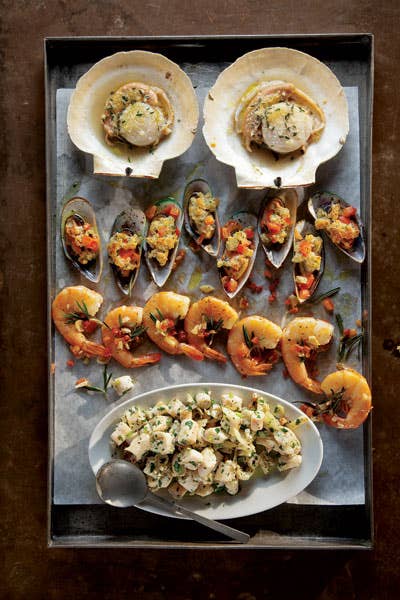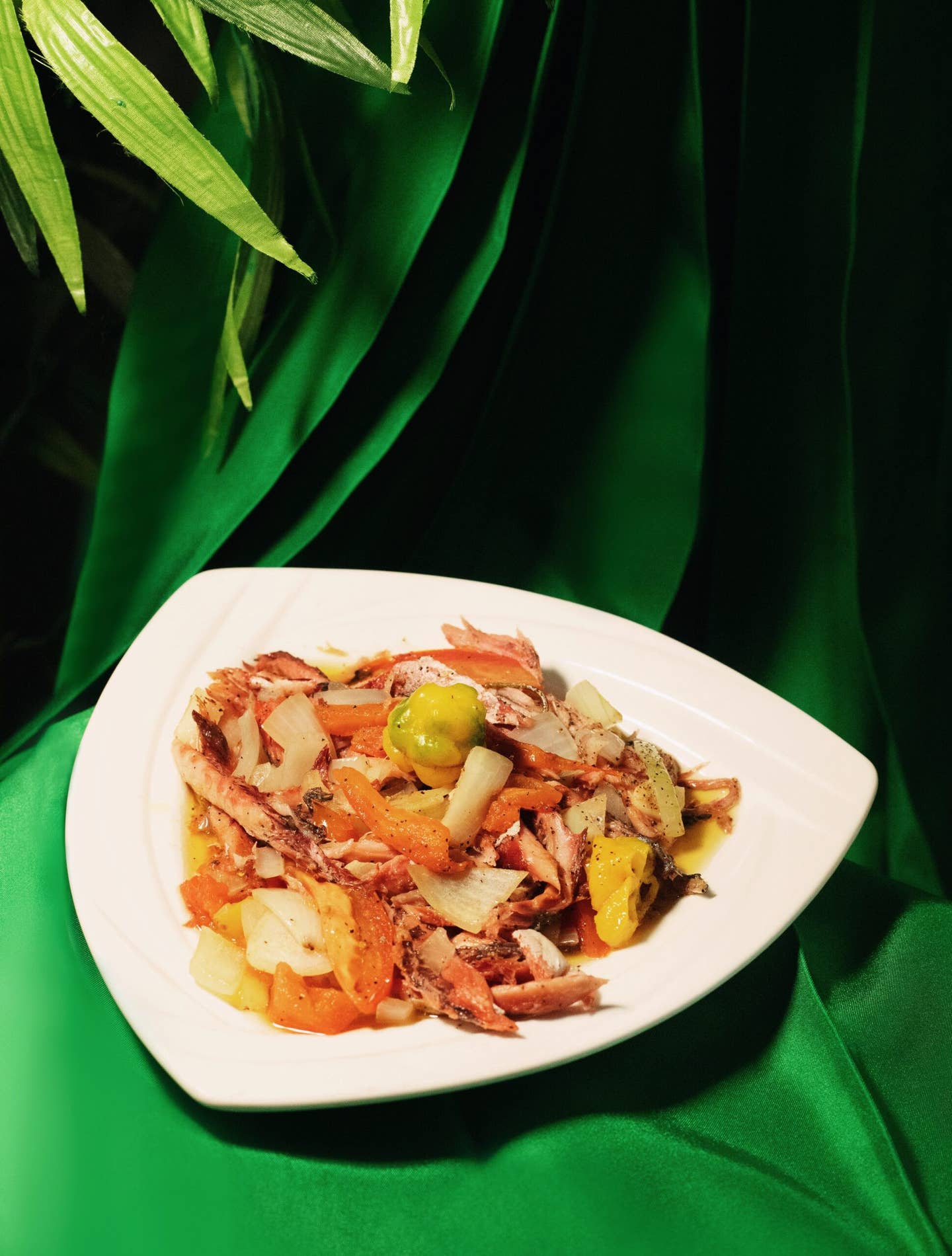
Good and Plenty: Venetian Cicheti
The colorful array of Venetian bites known as cicheti are the best way to sample the city’s unique cuisine
There's a moment I cherish in Venice, when the sun starts to set, the light turns silver, and the city appears more beautiful and improbable than ever. It's the time of day when Venetians are getting off work and their purposeful strides slow down to casual strolls, when the usual sounds of conversation that bounce between the narrow, stone-walled calli start concentrating around the city's bacari, or wine bars. That's when I start craving cicheti, the colorful small plates these eateries are famous for; the city's signature snacks.
Cicheti is a Venetian thing, and like most things Venetian—water taxis, mind-boggling species of fish, the high-heel wading boots women put on when ankle-deep acqua alta (flood waters), rolls in from the lagoon—you don't find them quite like this anywhere else in the world. Delicately seasoned deep-fried rice croquettes; sardines that are lightly fried and marinated with a sweet-sour tangle of caramelized onion; capesante, or sea scallops, broiled on the half shell under a blanket of bread crumbs and butter: These foods might very well resemble Spain's tapas or Greece's mezedes in their size and variety, and they in fact stem from the same old tradition of offering quick bites while imbibing or doing business, but they belong to no place other than Venice. The foods are bite-size expressions of the local cuisine, and the way you eat them—casually, frequently, not just at dusk as an appetizer, but as a snack between breakfast and lunch, or whenever you run into a friend on the street and decide to catch up over an impromptu meal—are borne out of Venice's uniquely pedestrian way of life. Insular and idiosyncratic, Venice can be a hard city to get to know, but it's when I'm eating cicheti that I feel I know it best.
I first encountered cicheti before I knew Venice very well. In 2000, I arrived to research a guide book, and one day the owner of my hotel, a sweet woman a few years my senior who had patiently given me directions to all the fancy restaurants I needed to check out, took me to a bar across the street. "I want to show you how Venetians really eat," she said.
I had passed the old-fashioned, wood-trimmed place, and others like it, dozens of times, and had written it off as a watering hole. But once I walked inside and over to the bar, I could see an expansive array of prepared foods; there were platters that stretched from the front window all the way down to the back room. As the barman fixed a plate with a little bit of everything—a scoop of creamy codfish mousse, a few crisp-fried meatballs, grilled polenta squares—my new friend shared the story of cicheti, and of Venice itself.
Venice, despite the way it may feel during high season, is a small town: Just 60,000 people reside in the old city, which you can walk across from one end to the other in about an hour. In the incomparable book The World of Venice (Harcourt Brace Jovanovich, 1974), the travel writer Jan Morris writes that Venice, "compact though the city is, remains criss-crossed with local flavors and loyalties. Each district, each clamourous market square has its own recognizable atmosphere—here harsh, here kindly, here simple, here sophisticated. Even more than London, Venice remains a collection of villages."
Over the years as I returned to the city, I came to know those villages through their cicheti. The unique spirit of each neighborhood, or sestiere, shines through in its bacari, and the different kinds of snacks they serve. There are places around the Rialto bridge, where cicheti likely originated as a quick meal that catered to the original merchants of Venice, that still look as they did 500 years ago; workingmen's bars that serve simple snacks like pieces of cheese on toothpicks, fried olives, and musetto, Venice's soft, mild sausage. And there are trendy places in residential neighborhoods that serve inspired, cheffy riffs on cicheti classics.
The word cicheti is Venetian dialect: Some think it stems from the French word chiquer, "to chew"; others believe its root is the Latin ciccus, meaning "trifle." Servings of cicheti usually cost no more than a euro or two, but the dishes speak to the city's rich history as a culinary crossroads, when trade on the Grand Canal brought spices and exotic ingredients from all over the world. No dish represents this more than baccala mantecato, a puree of dried, imported codfish (similar to the French brandade de morue) that has been rehydrated, boiled, then whipped with olive oil (purists never add cream) until light and airy. While cicheti is, first and foremost, food that Venetians eat outside the home, baccala mantecato is the kind of traditional dish that home cooks take pride in making: Every Venetian I know has their own version that they dollop on grilled polenta squares. Fine white polenta, made from a fair-kerneled corn that is planted in the area, is most traditional; while the coarser and corny yellow polenta is the norm elsewhere, Venetians' taste for the refined white variety stretches back to the days of the Doges, the rulers of the Venetian Republic from the Middle Ages through the end of the 18th century.
Another classic cicheti is sarde in saor, a legacy of Venice's seafaring tradition. Sardines, which are plentiful in the lagoon, the brackish body of water that surrounds the city, were traditionally fried and marinated with onions so they'd keep for long journeys by boat. Over time, they became a cicheti staple because they don't require refrigeration. As humble as the dish is, it's my favorite way to eat the fish, meaty and rich in its sweet-sour, aromatic marinade. It's often flavored with pine nuts and sultanas, and sometimes even cinnamon and saffron, vestiges of the city's storied spice trade. Other cicheti favorites include insalata di polpo, or marinated octopus, bright with parsley and lemon juice, and all manner of fried foods, from battered zucchini to tiny softshell crabs called moleche—frying being another method of preserving foods so they'll keep at room temperature on the bar.
As a cook, I love how cicheti speak to the seasons: You can always count on the local produce for sale at the Rialto market showing up simply prepared on cicheti bars. The beautiful artichokes from the nearby island of San Erasmo might end up fried, or marinated, or wrapped with pancetta and broiled. Peppers are stuffed with anchovies and preserved sott'olio, in olive oil; radicchio is sliced into wedges and grilled. Tramezzini, the Venetian triangles of squishy, crustless white bread that stem from the English tea sandwich tradition and appeared in northern Italy in the 1920s, are a canvas for all kinds of seasonal produce, with fillings like arugula, asparagus, and more.
The same is true for seafood: One summer day, long after that first trip to Venice, I went out with friends on their boat and harvested garusoli, Venetian whelks, from the sandy bottom of the lagoon. Later that night I saw the seasonal shellfish at a bacaro simply dressed. To me, there's no finer way to appreciate Venice's pristine seafood than to eat it as cicheti. I'll order a serving of granseola (spider crab), the meat, plucked from its shell and seasoned with its buttery orange roe, or a few of the many varieties of lagoon crustaceans: tiny brown shrimp called schie that are fried or boiled and served with polenta; scampi, the pink, impossibly sweet crayfish; and my absolute favorite, meaty, nutty-tasting canoce, or mantis shrimp, grilled and charged with lemon.
All of these foods go best with local wine—a rustic red refosco, say, or a bracingly crisp Soave—in a glass big enough for just a few gulps called un'ombra, itself a centuries-old tradition. Ombra is the Italian word for shadow: The city's wine merchants used to sell their wares in Piazza San Marco, moving throughout the day under the shadow of the campanile, or bell tower, to keep their wine cool. The other classic cicheti companion is a refreshing cocktail called a spritz (pronounced "spriss"), which Venetians adapted from an Austrian drink of sparkling water and white wine, by adding a touch of bitter Campari or sweeter Aperol.
The beauty of the ombra and the "spriss" is that they are designed to be light and restorative and fun, like cicheti are. Come dusk, whether I'm parked at a table along the Grand Canal, watching that gorgeous silver light on the proud, old crumbling palazzi as I nosh on cicheti, or in my kitchen at home in New York preparing these small plates for family and friends, there's no better way to enjoy Venice's singular cuisine.
Keep Reading
Continue to Next Story










